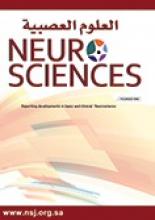Abstract
OBJECTIVE: To assess the effect of long-term use of computer mouse devices on the median nerves.
METHODS: A cross-section prospective study conducted during the year 2004 involved 41 male secretaries employed in the Health Colleges of King Khalid University in Abha, Kingdom of Saudi Arabia. A questionnaire describing sociodemographic and computer use was completed. The electrophysiological study included measurements of motor latencies, motor conduction velocities, and amplitudes of compound muscle action potential of the right median nerve and compared these with those of the left median nerve (control). All of our subjects were right handed. Terminal latency index (TLI) was calculated for each nerve tested. Entrapment neuropathy of the median nerve at the wrist was defined as TLI <0.30.
RESULTS: The mean TLI of the median nerve in the right hand was significantly lower than that in the left hand. Eight of the 23 asymptomatic participants (34.8%), 6 of the 12 who reported hand discomfort (50%), and all the 6 participants who met clinical criteria for carpal tunnel syndrome showed electrophysiological evidence suggestive of right median nerve entrapment neuropathy at the wrist. Test of association showed a negative and significant correlation between TLI of the right median nerve and weekly hours mouse device use while no significant correlation was found between TLI in the same hand and weekly hours keyboard use.
CONCLUSION: Frequent computer mouse device users are at high risk of developing median nerve entrapment neuropathy at the wrist.
- Copyright: © Neurosciences
Neurosciences is an Open Access journal and articles published are distributed under the terms of the Creative Commons Attribution-NonCommercial License (CC BY-NC). Readers may copy, distribute, and display the work for non-commercial purposes with the proper citation of the original work.






